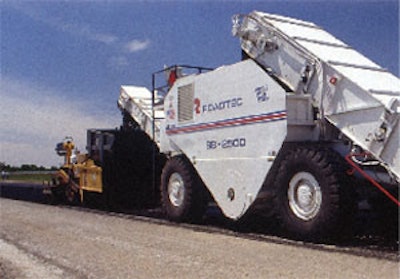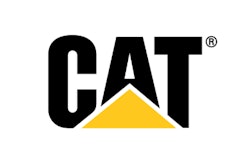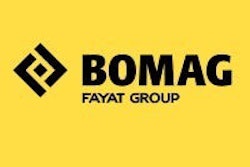
Indiana paving contractor E & B Paving Inc. is accustomed to challenging projects, and one of its most recent, a full-depth rehabilitation project of S.R. 69 in Posey County, certainly put this company to the test when it seemed like one problem after another required a ton of patience and perseverance just to complete the project.
The contract for the 10-mile stretch of road was let in 2000 and finally completed in 2004. The original $18.4-million contract consisted of 10 miles of new full-depth asphalt roadway, with new alignments crossing the existing road in at least 13 locations. Two-way traffic was maintained on the old road and segments of the new construction throughout the project. Two new bridges were constructed and one existing bridge received a deck overlay. Thirteen temporary runarounds were constructed to allow building new roadway sections that were on top of the old roadway. The contract also included demolition of several right-of-way parcels and extensive utility relocations by various utility companies.
"The project called for widening and realignment (straightening) an existing two-lane highway," says Steve Henderson, regulatory affairs director for E & B Paving. "We had a lot of switchbacks to deal with and still maintain an open road for traffic during construction. Whatever could go wrong with a project did go wrong, but we managed to pull it all together and eventually win a smoothness award from the Indiana Department of Transportation."
Pavement details
The old roadway was a 24-foot wide, two-lane asphalt highway with unimproved shoulders. The new road is a 24-foot wide asphalt highway with 10-foot wide asphalt shoulders, and a mile long 12-foot wide truck lane was also constructed to improve safety. Sixteen crossroads and intersections were also rebuilt.
The original plans called for mainline pavement that was 13 inches of asphalt on a dirt subgrade. During construction, it became apparent that this design was not going to suitably support the heavy truck traffic going to the Ohio River port at Mt. Vernon. Investigation by INDOT determined that the original CBR value used in the design may not have been correct for the native silty soils and traffic loadings. Consequently, INDOT added a three-inch intermediate layer to the entire contract and changed the planned asphalt surface from 1 1/4 inch of 9.5mm QC/QA mix with PG 70-22 binder to 1 1/2 inch of 9.5mm SMA (stone matrix asphalt) mix with PG 76-22 binder.
Final construction of the mainline road consisted of 20,000 tons of three-inch QC/QA 25mm base with PG 70-22 AC binder, 28,000 tons of 3-inch HMA C-25mm base with PG 64-22 AC binder (this was an open-graded drainage layer), 25,000 tons of 3-inch QC/QA HMA 25mm base with PG 70-22 AC binder, 22,000 tons of 2 3/4-inch QC/QA HMA 19mm intermediate course with PG 70-22 AC binder, 21,500 tons of 3-inch QC/QA HMA 19mm intermediate course with PG 70-22 AC binder (this was the added layer required to handle projected traffic volume), and 12,500 tons of 1 1/2-inch HMA 9.5mm surface mat with PG 76-22 AC binder.
E & B Paving used a Roadtec RP 185-10 track paver on the first asphalt lift and stone base lays with a 30-foot non-contact sonar ski pole. Subsequent lifts were accomplished with a Roadtec RP 180-10 and RP 190-10 rubber-tired pavers with the non-contact sonar ski pole. Dual 50-foot traveling stringline ski poles were used on the final two mainline layers. A Roadtec SB 2500-C Shuttle Buggy was also used to facilitate the placement of the last four layers of asphalt. The rolling train for the first five asphalt layers consisted of an Ingersoll-Rand DD-110 vibratory tandem followed by a Cat CB-634C vibratory tandem. The rolling train for the final SMA surface mat consisted of the DD-110 and CB-634C, followed by a Bomag BW 9 AS static tandem finishing roller.
These changes were implemented to overcome the apparent lack of strength in the original typical section. The change order raised the original contract from $18.4 million to $22.4 million.
Problems from the start
The original grading subcontractor E & B hired went out of business shortly after the project began. Very little progress had been achieved on the project due to the subcontractor's lack of performance, right-of-way issues, utility reconstruction still underway, difficult soil conditions and wet weather. Fortunately, INDOT was understanding of the circumstances and allowed for some changes in scheduled work days during early phases of the project.
Another grading subcontractor was hired and all right-of-ways were cleared through the 2002 construction season. E & B and its grading contractor continued to move dirt by conventional methods and place asphalt, phase by phase, switching traffic each time, through 2003 and in early 2004. However, it became apparent that drying the native soils by conventional methods was taking too long to guarantee a 2004 job completion. Both the paving contractor and the grading contractor agreed to lime stabilize the remaining 40,000 cubic yards of fill required to complete the road base in order to meet a December completion deadline. The out-of-pocket expense for this operation totaled approximately $325,000. When the project was completed, E & B was penalized $135,000 for going over the 235 contracted work days by 45 days, so the out-of-pocket expense to lime stabilize remaining fill to keep the project on schedule avoided additional delay penalties.
And despite the challenges E & B Paving encountered on the project, the contractor received INDOT's 2004 Smoothness Award for full-depth asphalt.
"There were profilograph provisions that they had to achieve, and we have a research and training department that conducts an independent test of the project once completed to evaluate the smoothness of ride based on meeting or exceeding specifications," states Martson Fowler, construction engineer for INDOT's Vincennes District.
While the smoothness award did not provide an additional financial incentive for E & B Paving, according to Fowler, it does provide "something to boast about" in the company's marketing efforts. But more importantly, the project provided a lot of satisfaction for the crews involved, determined not to be deterred in delivering a quality pavement regardless of the circumstances.
Company evolution
E & B Paving Inc. was incorporated in 1967 with one plant located at Irving Brothers' stone quarry in Muncie, IN. The principal officers at the time were Jack R. Euratte and Richard Bedwell.
Ten years later, E & B Paving acquired its second plant at Stony Creek east of Noblesville, IN.
E & B has been involved with asphalt resurfacing on a wide variety of federal, state, municipal and commercial projects over the years. Two more production facilities were purchased from Mohr Construction in 1984. The company added its first portable plant in 1986 to accommodate an $8.4-million resurfacing project on US 30 in Whitley County, which, at the time, was the company's largest single contract.
In 1986, E & B also acquired Acme Paving Co. of Anderson, IN, adding five more production facilities. The company also moved its headquarters and repair shop from Noblesville to its present location in Anderson in 1987.
Historically, E & B has stayed on the fringes of the Indianapolis market, preferring to confine operations to the northeast quadrant out of Noblesville. Due to increased demand and a strong, growing market, the contractor opened an Indianapolis office and plant on the south side in 1988.
E & B's rapid growth continued with the acquisition of McMahan-O'Connor Construction Co. of Rochester, IN in 1992. The acquisition expanded E & B's asphalt paving capabilities and added concrete paving, bridge construction and earthmoving expertise to its service offering.
The company acquired Marion Paving Co. in Marion, IN in 1994. In 1997, E & B opened its Evansville office and plant, and expanded into Northeast Indiana by acquiring the Ft. Wayne office and asphalt plants of Ft. Wayne and Angola from S.E. Johnson in 2001. The company's most recent acquisition came in 2003 with the purchase of Mohr Construction Company in Kokomo, IN.
The company today is strategically located to serve a wide area of Central and Northeastern Indiana.












![Lee Boy Facility 2025 17 Use[16]](https://img.forconstructionpros.com/mindful/acbm/workspaces/default/uploads/2025/09/leeboy-facility-2025-17-use16.AbONDzEzbV.jpg?ar=16%3A9&auto=format%2Ccompress&fit=crop&h=135&q=70&w=240)








